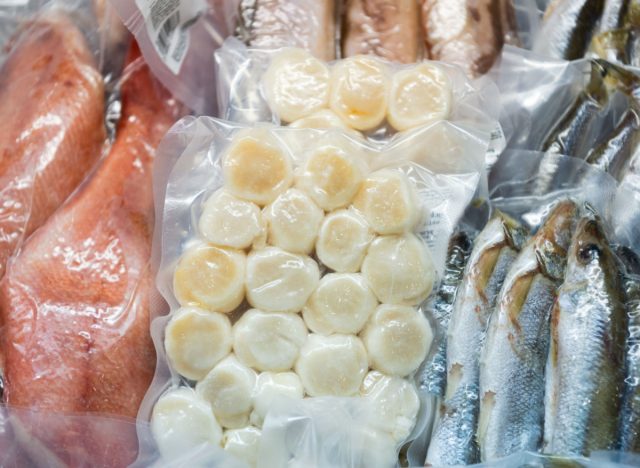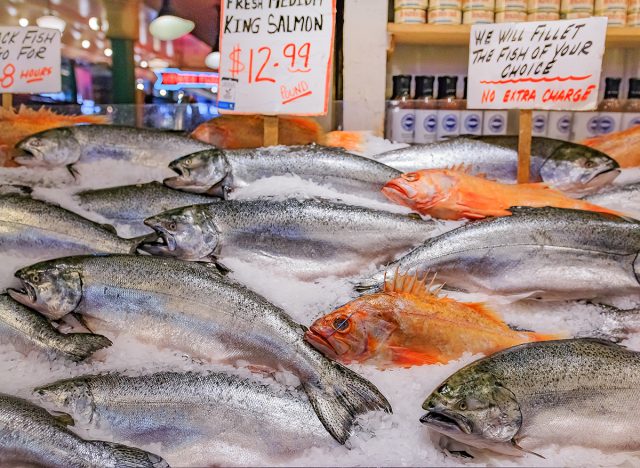How to Choose the Best Seafood at the Grocery Store, According to Chefs

So, it's grocery day once again. You go in confident with your list, prepared to tackle each department head on and even equipped with back-up options should anything not be available. You expertly navigate the wild jungle of the produce section, make selections at the meat counter with ease, and breeze through other countless aisles filled with dairy products, bakery items, dry goods, and more. But then, you reach the seafood.
The old adage "there's plenty of fish in the sea" is certainly true. And, depending on where you shop, there's plenty to choose from at the grocery store, as well. From countless species of fish to shellfish like lobster and crab and even octopus or squid, all those eyes staring you down can make you want to run for the checkout aisle with a seafood-less cart. But, you also likely know the health benefits that accompany this entire category of food, making it hard to pass up—seafood is known to be high in protein, omega-3 fatty acids (healthy fats), and full of other essential vitamins and minerals.
So, to give you a confidence boost for your next visit to the seafood counter, we've asked knowledgeable chefs and fishmongers to give their top pieces of advice. Read on to learn how the best in the business go about selecting their own fish and seafood, even including both where and when they choose to shop.
Check the harvest date

It may come as second nature to you to check the various "sell by" and "use by" dates which are found on grocery items like dairy and meat. But what you want to pay close attention to when buying fresh seafood is the "harvest date," says Beau Owens, executive chef at The Lazy Goat in Greenville, S.C.
The harvest date tells you when the fish or other seafood was caught, and some items may even have a "final harvest date" or "wet storage date" listed, which is the date it was taken out of the water holding tank to be shipped. "Most fish and seafood in general are flown or shipped in, and transported over a few days," says Owens. So, in general, the more recent harvest date, the better.
For items that are not prepackaged and tagged at the seafood counter—such as oysters, crab legs, or even something like scallops—make sure to ask the seafood clerk to provide you with its harvest information before purchasing.
Look for aquaculture certification

At the seafood counter, you may come across labels that say either farm-raised–meaning it was bred and harvested in a controlled habitat—or wild-caught, and wonder which is better. Both have their pros and cons, but Owens recommends reaching for farm-raised varieties "because there are strict standards set in place for the product."
Specifically, you should look for farm-raised fish and other seafood sporting a Best Aquaculture Practices (BAP) Certified and/or a Aquaculture Stewardship Council (ASC) Certified label. These certifications indicate that the seafood was both sustainably and responsibly farmed.
Pay close attention to smell, eyes, gills, and texture

Although it may seem a little strange, Owens adds that you should test the waters and ask to hold the seafood. "Fish should be firm and smell like the ocean," he shares. On the other hand, he says "shellfish should not have any fishy odor, and it should be free of any oily substance that feels slippery. This is a sign that the product has started to break down and will sour soon."
In addition to a mild smell, chef Charlotte Langley notes there are a few other dead giveaways that your seafood is quality. The chief culinary officer at Scout Canning and chef ambassador to the Marine Stewardship Council (MSC) says to look for clear glassy eyes, red gills, and look closely at the texture. "When fish is fresh and handled with care, the filet has little to no cuts, tears or rips," she says. "As it ages, the fish becomes more waterlogged and splits along any lines that were cut quickly."
Don't overlook frozen seafood

Fresh seafood isn't your only option, or sometimes even your best one. Owens says that frozen fish is often superior to fresh because "it is frozen on the boat or as soon as the fish hits the dock."
Langley adds that "most fresh seafood at the grocery comes frozen and is thawed to order for the fish station." So, she says it would behoove you to eliminate this middle step and just purchase the frozen selections directly. "You can pull as much as you need from the freezer, and lots of seafood, especially MSC-certified wild seafood, comes in 4-6 portions per package," she continues. "The portions are so handy, thaw quickly and help manage your portion sizes."
Don't shop just anywhere

When it comes to picking out the best seafood, chef Jarrod Moiles says it all starts with where you shop. Moiles is the corporate executive chef and director of food and beverage at Pacifica Enterprises, currently overseeing food programs at the Lakehouse Resort, Belmont Park, and other San Diego hot spots.
He recommends going with "smaller local or higher end markets when shopping for fish," rather than at a big-box store or supermarket chain. Buying local means fewer steps in the supply chain from fisherman to consumer, ensuring fresher seafood and a more environmentally friendly process. More specialized local markets are also likely to have more options, variety, and more knowledge including when and where the seafood was caught.
Shop on the busiest days

That's right. It may seem counterintuitive, but Moiles says to pick up your catch of the day during the grocery store's busiest days, which tends to be over the weekend from Thursday to Sunday. "Retailers typically purchase the same way," he explains. "You can expect fresher fish during this time. Plus, you can expect the rotation of the seafood to be better."
In general, a crowded fish market or seafood counter at the grocery store is always a good sign no matter what day of the week. So, you may need to be prepared to battle the masses to get your hands on the best seafood, but it will be well worth it.
Talk to the seafood clerk

Shopping for seafood is not a time when you want to be timid. When in doubt, or if you have specific fish or seafood-related questions, simply ask the person at the counter. This was a shared suggestion among all three chefs.
"Talk to the person working at the counter and ask them about the product, they are going to have the best information on the product for sale," says Moiles. "The fishmonger is your friend. Ask them what they recommend, is this wild or farmed, tell them what profile of seafood you like. They will be very helpful. This is always my first thought when going to buy seafood at the market."
Keep an open mind

"When I buy seafood at the market, I always look for clean dry filets, loins, or sides," Moiles adds as his last tip. "I never go in looking to buy a specific fish, because I am just looking for what is fresh." He recommends that all shoppers do the same and have an open mind when they walk up to the counter.
Owens gives similar advice, also mentioning that you should always go with what's in season or currently readily available since not all seafood is available year round. For example, from spring into early summer is a great time for soft shell crab and Pacific salmon, but in the fall you may want to reach for scallops or oysters.









